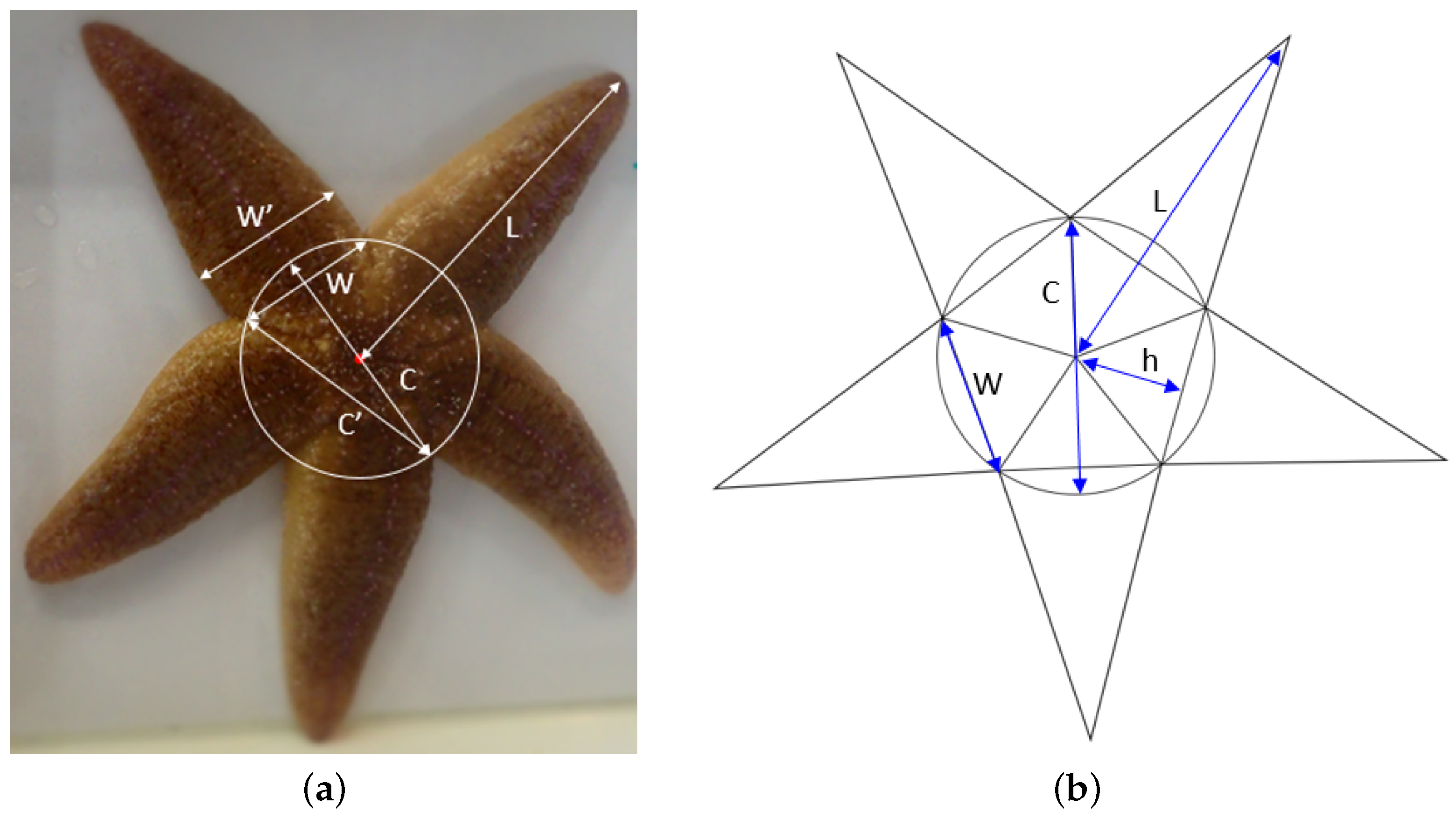Morphology and Settling Velocity of Sea Stars (Asterias rubens)
Abstract
:1. Introduction
2. Material and Methods
2.1. Specimen Collection
2.2. Biometric Measurements
2.3. Geometric Sea Star Model
2.4. Settling Velocity Experiment
2.5. Drag Coefficient
3. Results
3.1. Distribution of Lengths
3.2. Width and Thickness
3.3. Volume and Density of Sea Stars
3.4. Mass–Length Relationship
3.5. Drag Coefficient and Settling Velocity
4. Discussion
5. Conclusions
Author Contributions
Funding
Institutional Review Board Statement
Informed Consent Statement
Data Availability Statement
Acknowledgments
Conflicts of Interest
References
- Barkhouse, C.; Niles, M.; Davidson, L.A. A literature review of sea star control methods for bottom and off bottom shellfish cultures. Can. Ind. Rep. Fish. Aquat. Sci. 2007, 279, 1–44. [Google Scholar]
- Budd, G.C. Asterias rubens Common Starfish. 2022. Available online: https://www.marlin.ac.uk/species/detail/1194 (accessed on 18 June 2022).
- Calderwood, J.; O’Connor, N.E.; Roberts, D. Efficiency of starfish mopping in reducing predation on cultivated benthic mussels (Mytilus edulis Linnaeus). Aquaculture 2015, 452, 88–96. [Google Scholar]
- Magneson, T.; Redmond, K.J. Potential predation rates by the sea stars Asterias rubens and Marthasterias glacialis, on juvenile scallops, Pecten maximus, ready for sea ranching. Aquac. Int. 2012, 20, 189–199. [Google Scholar]
- Dare, P.J. Notes on the swarming behaviour and population density of Asterias rubens L. (Echinodermata: Asteroidea) feeding on the mussel, Mytilus edulis L. J. Cons. Cons. Perm. Int. Pour L’Explor. Mer. 1982, 40, 112–118. [Google Scholar] [CrossRef]
- Holtegaard, L.E.; Gramkow, M.; Petersen, J.; Dolmer, P. Biofouling og Skadevoldere: Søstjerner; Technical Report; Dansk Skaldyrscenter: Nykøbing Mors, Denmark, 2008. [Google Scholar]
- Sloan, N.A. Aspects of the feeding biology of Asteroids. Oceanogr. Mar. Biol. Annu. Rev. 1980, 18, 57–124. [Google Scholar]
- Orton, J.H.; Fraser, J.H. Rate of growth of the common starfish, Asterias rubens. Nature 1930, 126, 567. [Google Scholar] [CrossRef]
- Vevers, H.G. The Biology of Asterias Rubens L.: Growth And Reproduction. J. Mar. Biol. Assoc. UK 1949, 28, 165–187. [Google Scholar] [CrossRef] [Green Version]
- Nichols, D.; Barker, M. Growth of juvenile Asterias rubens L. (Echindermata: Asterioidea) on an intertidal reef in southwestern Britain. J. Exp. Mar. Biol. Ecol. 1984, 78, 157–165. [Google Scholar] [CrossRef]
- Castilla, J.C. Responses of Asterias rubens to gravity. Behaviour 1975, 72, 84–94. [Google Scholar] [CrossRef]
- Castilla, J.C.; Crisp, D.J. Responses of Asterias rubens to water currents and their modification by certain environmental factors. Neth. J. Sea Res. 1973, 7, 171–190. [Google Scholar] [CrossRef]
- Castilla, J.C.; Crisp, D.J. Responses of Asterias rubens to olfactory stimuli. J. Mar. Biol. Assoc. UK 1970, 50, 829–847. [Google Scholar] [CrossRef]
- Hermes, M.; Luhar, M. Sea stars generate downforce to stay attached to surfaces. Sci. Rep. 2021, 11, 4513. [Google Scholar] [CrossRef]
- Ellers, O.; Khoriaty, M.; Johnson, A.S. Kinematics of sea star legged locomotion. J. Exp. Biol. 2021, 224, jeb242813. [Google Scholar] [CrossRef] [PubMed]
- Fredsoe, J.; Deigaard, R. Mechanics of Coastal Sediment Transport; World Scientific: Singapore, 1992. [Google Scholar]
- Barker, M.; Nichols, D. Reproduction, recruitment and juvenile ecology of the starfish Asterias rubens and Marthasterias glacialis. J. Mar. Biol. Assoc. UK 1983, 63, 745–765. [Google Scholar] [CrossRef]
- Belmonte, A.; Eisenberg, H.; Moses, E. From Flutter to Tumble: Inertial Drag and Froude Similarity in Falling Paper. Phys. Rev. Lett. 1998, 81, 345–348. [Google Scholar] [CrossRef] [Green Version]
- Andersen, A.; Pesavento, U.; Wang, Z.J. Analysis of transitions between fluttering, tumbling and steady descent of falling cards. J. Fluid Mech. 2005, 541, 91–104. [Google Scholar] [CrossRef]
- Froese, R. Cube law, condition factor and weight–length relationships: History, meta-analysis and recommendations. J. Appl. Ichthyol. 2006, 22, 241–253. [Google Scholar] [CrossRef]
- Shanker, S.P.; Vijayanand, A.A.; Shyni, A. The Relationship between the Length and Weight of the Sea Star Pentaceraster Regulus (Muller and Troschel, 1842). Int. J. Zool. Anim. Biol. 2018, 1, 000122. [Google Scholar]
- West, G.S.; Apelt, C.J. The effects of tunnel blockage and aspect ratio on the mean flow past a circular cylinder with Reynolds numbers between 104 and 105. J. Fluid Mech. 1982, 114, 361–377. [Google Scholar] [CrossRef]
- Siemann, L.A.; Davis, F.H.; Bendiksen, T.A.; Smolowitz, R.J. Scallop dredge design using computational fluid dynamics and flume tank testing and the application of both methods to improving a low profile dredge. Fish. Res. 2021, 241, 105998. [Google Scholar] [CrossRef]
- Mehta, A.J.; Lee, J.; Christensen, B.A. Fall velocity of shells as coastal sediment. J. Hydraul. Div. 1980, 106, 1727–1744. [Google Scholar] [CrossRef]














Disclaimer/Publisher’s Note: The statements, opinions and data contained in all publications are solely those of the individual author(s) and contributor(s) and not of MDPI and/or the editor(s). MDPI and/or the editor(s) disclaim responsibility for any injury to people or property resulting from any ideas, methods, instructions or products referred to in the content. |
© 2023 by the authors. Licensee MDPI, Basel, Switzerland. This article is an open access article distributed under the terms and conditions of the Creative Commons Attribution (CC BY) license (https://creativecommons.org/licenses/by/4.0/).
Share and Cite
Burgaard, K.B.; Carstensen, S.; Fuhrman, D.R.; Saurel, C.; O’Neill, F.G. Morphology and Settling Velocity of Sea Stars (Asterias rubens). J. Mar. Sci. Eng. 2023, 11, 296. https://doi.org/10.3390/jmse11020296
Burgaard KB, Carstensen S, Fuhrman DR, Saurel C, O’Neill FG. Morphology and Settling Velocity of Sea Stars (Asterias rubens). Journal of Marine Science and Engineering. 2023; 11(2):296. https://doi.org/10.3390/jmse11020296
Chicago/Turabian StyleBurgaard, Karen B., Stefan Carstensen, David R. Fuhrman, Camille Saurel, and Finbarr G. O’Neill. 2023. "Morphology and Settling Velocity of Sea Stars (Asterias rubens)" Journal of Marine Science and Engineering 11, no. 2: 296. https://doi.org/10.3390/jmse11020296




